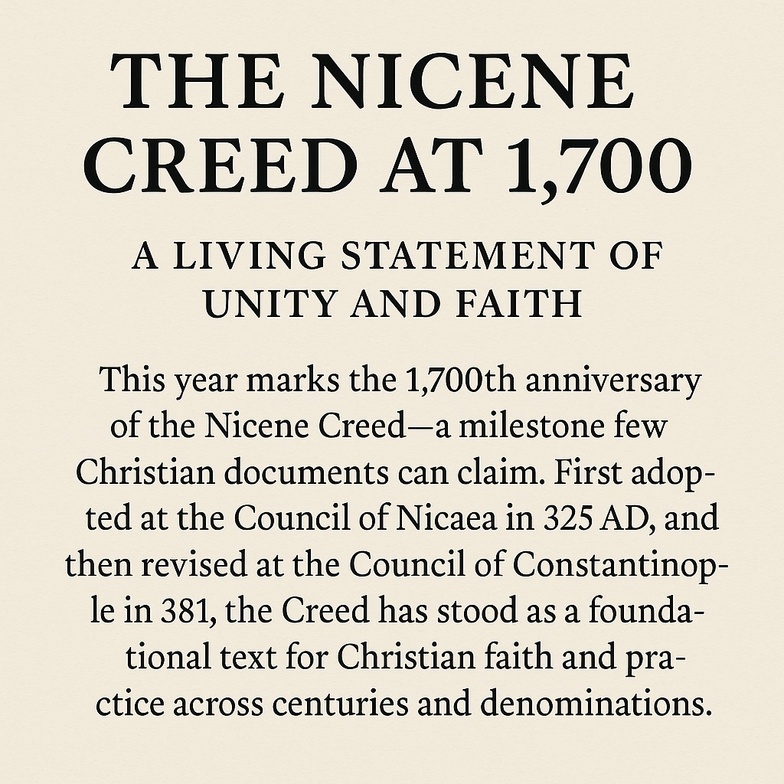
This year marks the 1,700th anniversary of the Nicene Creed—a milestone few Christian documents can claim. First adopted at the Council of Nicaea in 325 AD, and then revised at the Council of Constantinople in 381, the Creed has stood as a foundational text for Christian faith and practice across centuries and denominations. In many ways, it is Christianity’s common grammar—clarifying how we speak about God, Jesus, the Holy Spirit, and the Church.
A Creed Born of Controversy, Shaped for Unity
The early fourth century was a time of intense theological debate. The Church had emerged from persecution and was wrestling with major questions about who Jesus is in relation to God the Father. The Council of Nicaea was convened to seek clarity and consensus, and what emerged was the first version of what we now call the Nicene Creed.
This was not simply a theological treatise—it was a statement of unity. It helped draw the boundaries of orthodox belief and gave the early Church a shared confession of faith. The creed was further refined at Constantinople to affirm the full divinity of the Holy Spirit and solidify a Trinitarian understanding of God.
Notably, this wasn’t a dry, academic exercise. The debates were so passionate that—according to tradition—St. Nicholas (yes, that St. Nicholas) became so incensed at one point that he struck the heretic Arius during the council. While the details are more legendary than confirmed history, the story captures the intensity with which the Church sought to protect the truth about Christ.
It is remarkable that a text forged in such a charged historical context still resonates today, uniting Christians across centuries and continents.
An Ecumenical Touchstone
Unlike many expressions of Christian identity, the Nicene Creed is ecumenical by nature and design. It is one of the few confessions affirmed by almost every major branch of the Church:
- Roman Catholic
- Eastern Orthodox
- Anglican
- Lutheran
- Reformed and Presbyterian
- Methodist
- Many Evangelical traditions
It remains a central part of baptismal liturgies, Eucharistic prayers, and daily worship. When we say the Nicene Creed, we do not simply repeat ancient words—we join a vast communion of believers, past and present, in declaring what binds us together.
Living Language: The ELLC/Common Text Version
Of course, language evolves. Over the centuries, the Creed has been translated and retranslated to reflect changes in spoken English, cultural context, and theological clarity.
One of the most significant recent developments came in 1988, when the English Language Liturgical Consultation (ELLC) released an updated English translation of the Nicene Creed, alongside new versions of the Apostles’ Creed and the Lord’s Prayer. This version is often called the Common Text, and it aims to retain the original meaning while addressing issues such as inclusive language and clarity for contemporary worshippers.
For example, the ELLC version reads:
“For us and for our salvation he came down from heaven,
was incarnate of the Holy Spirit and the Virgin Mary,
and became truly human.”
This reflects the original Greek much more closely than the older phrase “was made man,” and removes ambiguity about whether “men” meant males specifically or humanity as a whole.
Who Uses the ELLC/Common Text?
This version of the Creed has been widely adopted across denominations, including:
- The Anglican Church of Canada
- The Evangelical Lutheran Church in Canada (ELCIC)
- The Episcopal Church (USA)
- The Evangelical Lutheran Church in America (ELCA)
- The United Methodist Church
- The Presbyterian Church (USA)
- And other ecumenical partners around the world
It is used both in liturgical books and in shared ecumenical worship services.
Why It Still Matters
In a world where division and individualism often dominate, the Nicene Creed reminds us that Christianity is fundamentally communal. It connects us not only with our local parish community but with a global and historical body of believers. It roots us in the mystery of God’s saving work in Christ and the ongoing presence of the Holy Spirit in the Church.
And by continuing to revisit and renew how we speak these words—through efforts like the ELLC—we affirm that this ancient Creed is not a relic, but a living confession. It speaks to our present and guides our future.
As we mark 1,700 years of the Nicene Creed, may we be reminded that our faith is not only something we hold, but something that holds us—together.




